Vaccine fever
The queue for those aged between 18 and 44 years, with appointments to get the first shot of the Covid-19 vaccine, is about 100 people long when we join it. The only reason I’m in it is because I’m inordinately lucky. Luck is not a word that we should associate with a vaccination drive during a pandemic and yet… .
The day CoWin opened up to everyone — May 1 — the site crashed multiple times. I’m among those who couldn’t register, but Saumya did and she registered me under her number. For the past week, Saumya and I have been tracking BMC’s Twitter handle and multiple Telegram channels that ping each time registrations open. Hundreds of slots disappear in a matter of seconds. We both despaired. Every evening that we failed at this Hunger Games-meets-Kaun Banega Crorepati’s “fastest finger first” hybrid (aka phase three of India’s vaccination drive), I became a little more resigned to not getting the shot while Saumya got more determined to crack the system. There were still silver linings. I was able to alert three friends who had been struggling to find slots for their parents; two of them got appointments. We all cheered, as though they’re our own parents. Grief is not the only thing we share in the age of Covid.
By May 6, we’re seeing updates on social media of people who have driven as far as Thane, Navi Mumbai and Badlapur to get their shots. At some point, officials and locals in those areas will start grumbling about privileged, car-owning Mumbaikars “stealing” vaccines from them. Saumya and I did not consider those far-flung centres as options — it’s true that neither of us wanted to swoop in on someone else’s share of vaccines, but the primary reason for our higher moral ground was that we were not willing to go any further north than Ghatkopar. We’re happy to pay for the vaccine, but our upper limit for the commute was 13 kilometres.
Of course, no one should have to pay for these vaccines except governments, whose responsibilities include ensuring the welfare of citizens, but the world is anything but ideal. If the Indian government’s strategy behind allowing private hospitals to sell the vaccines was to ease the load on civic authorities supplying free vaccines, it doesn’t seem to be working (leaving aside the minor detail of this being an example of our government effectively encouraging private hospitals to profiteer from the pandemic). As things stand right now, private hospitals have to procure their own supplies of vaccines while states receive their supplies via the Centre. CoWin is the only platform through which you can book an appointment at either a private hospital or a government-run centre and there is no uniformity. The menu card of vaccines lists prices ranging from Rs 500 to Rs 900 in Mumbai. My mother tells me that it’s crossed the Rs 1,000 mark in Kolkata. Each municipal corporation has different timings for their slots. BMC opens registrations at 7.30pm on one day, 8pm on another, 7.45pm on yet another and the only way you can know this is if you’re stalking their Twitter handle. Private hospitals open their windows at different hours of the day — 2pm for one, 5pm for another, a third allows advance bookings if you check at 4pm on certain days of the week — and there are no formal announcements. Saumya and I have postgraduate degrees, we’ve worked as journalists for more than a decade, we have good computers and internet connections. If we’re frustrated by CoWin, how are those with unstable data networks, cheap hardware and limited English literacy negotiating this process?
Compared to the 500-odd slots that civic authorities open up daily, private hospitals offer approximately 100. They disappear in a second, sometimes less. Both Saumya and I agreed that we had a better chance of getting appointments at places with more slots. Saumya kept the CoWin page open on her computer throughout the day, logging in repeatedly, trying multiple times and noting the changes that were introduced without warning — an extra OTP here, a “secret code” there. Every evening, after failing, we spent a few minutes wondering how the bulk of the Indian population can even hope to crack CoWin (which has only an English-language version. Ironic, given most BJP members struggle with English and the party’s long campaign for Hindi supremacy). CoWin, developed and managed by the BJP government at the Centre, seems designed to be accessible to the least number of people and penetrable by only the most privileged. So much for a political party that projects itself as champion of the son of the soil.
The day it finally happened, I wasn’t even near my phone or computer, which is to say I was of absolutely no help to Saumya who didn’t plead off the staring contest with CoWin. That day, the bad news felt too much. I am safe, my families are safe, and yet I’m breaking under the weight of the updates that stream in through my phone and computer. Every ripple that reaches me shimmers with either death or the fear of it. That day, too many people had been reduced to a flicker of a memory. We were told as kids that sharing means there is more for everyone. I’m learning in my middle age that this holds true of grief and uncertainty.
And yet, I find that no matter how much I may want to build for myself a hiding place made of white noise and night-calm darkness, I spiral back to check for updates. I would rather know and retreat than be delusional like our government which believed the pandemic was over when cases dipped earlier this year and which continues to maintain CoWin is a functioning system and there are no shortages in the country. So I returned to my phone minutes after resolving to set it aside and found Saumya’s missed call. I called her back, my heart slowing down as though preparing for bad news even though I knew she and hers were fine. “Tomorrow, Nair Hospital, both of us,” Saumya said. It was as close to a miracle that we can hope for in our day and age. Saumya, my vaccine fairy, had got appointments for the first shot of Covishield.
Which is how we’re in a queue on May 8. We’re both carrying bottles of water in our bags. I am also carrying two bars of chocolate. Yet the fact is that given we’re in a hospital that treats Covid patients and standing in a socially-undistanced queue, I doubt either of us would lower our masks even if we were about to pass out with dehydration and hunger. Thanks to Mumbai humidity, my mask at this point is basically a receptacle for sweat. We look around to distract ourselves and spot a doll impaled upon the whorls of barbed wire on the boundary wall.
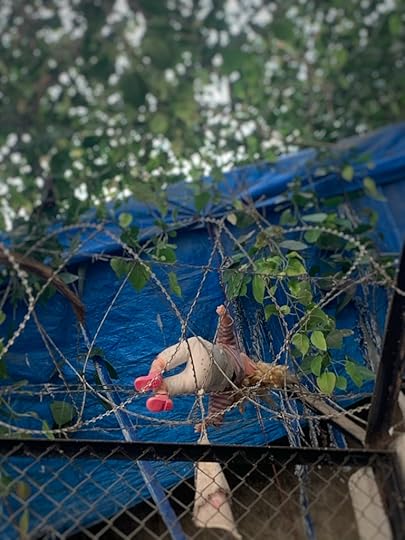
The line behind us has snaked beyond my line of sight. As far as I can see, it’s people like us — young, upper middle-class, smartphone-wielding and privileged. In the middle of a raging second wave, it’s true that every person vaccinated is a step in the right direction, but this queue should have been filled with those who have little choice but to brave the pandemic in order to make a living; people like drivers, delivery people, domestic help, grocery store workers. Instead it’s filled with people who can work from home. For people like us, it really is a free vaccine, but for those who are less privileged, there are hidden costs. These range from what the English-literate middleman will charge for trying their luck with CoWin; to earnings lost from first queuing up for the vaccine and then the potential side effects like fever, diarrhoea and body ache that knock most of us out for two days.
India has spent the last few decades pretending it’s a superpower and now, the bubble of that dream has been pricked by Covid-19. The pandemic has reminded us with brutal force that we are in fact a poor country with a crippled economy. We cannot afford the number of tests that we should be conducting, we cannot afford the gene sequencing that we should be doing to identify variants and their traits, and we cannot afford vaccines in the amount that we need them. As if all the complicated legalities surrounding patents and production of vaccines didn’t pose enough of a challenge to vaccine distribution, the BJP government has turned the vaccination drive into a publicity stunt. In April, possibly to boost the BJP’s chances in state elections that were being conducted at the time, the Prime Minister announced vaccination would be made available to everyone from May 1 even as states struggled to reach their targets of vaccinating frontline and healthcare workers. More people were testing positive, thanks to a second wave that was made infinitely worse by irresponsible election campaigning and the government’s decision to organise the Hindu pilgrimage festival of Kumbh Mela. (Both the election rallies that gathered thousands of people as well as the crowds at the Kumbh Mela proved to be super spreaders. There are now concerns that these large gatherings may have helped the virus to mutate into strains that may be vaccine-resistant.) Meanwhile, even as vaccination was opened up to everyone, vaccines were in short supply across the country.
While India broke record after record in terms of daily caseloads and made international news for under-reporting Covid deaths, BMC would close vaccination centres for three days because Mumbai had no supplies. Unnamed sources told Business Standard that the Central government, which is in charge of Covid management and the vaccination drive, had last placed an order for 120 million vaccines more than month ago, in March. Earlier this week, in May, the Centre announced it had (finally) ordered 160 million more doses of Covishield and Covaxin. Even so, Thane Municipal Corporation announced that tomorrow, there would be no vaccination for the 45+ age category — the targets of the second phase of the vaccination drive — because it doesn’t have vaccines. Earlier, there was a stampede in a vaccination centre in Mumbai and friends in Bengaluru described how they’d arrived and waited for hours at vaccination centres only to be told there weren’t enough vaccines by the time it was their turn. Doctors in India started spreading the word that there was no need for concern if you didn’t get the second dose after a month, as was originally prescribed; that the efficacy was better if the gap was extended; that you could even get the second shot after six months.
All this is to soothe the panic of the privileged, who want their security against this dreaded disease right now. Meanwhile, those most vulnerable to contracting Covid-19 continue with their daily lives, opening shops and cleaning homes and driving public transport. Not that we can begrudge anyone their anxiety. Covid is terrifying for just how unpredictable it is. Last year, rural India had felt safe against it, seeing it as a city illness, but this year, it’s ravaging the hinterland. The new variants of Covid-19 are more transmissible and this time round, more children are contracting the infection (last year, children were considered least vulnerable to Covid). In one person, the illness is a little worse than a common flu. In another, it can mean death in a matter of days or even hours. In the hellscape that is Uttar Pradesh and Delhi, the dead are being burned on pavements and parking lots, and the ailing are gasping for breath. Local newspapers in states like Gujarat have embarked on a campaign to show the discrepancies in the official count of Covid deaths. Goa recently reported a positivity rate ranging from 40-51%.
While the Prime Minister and other BJP leaders issue statements that claim the pandemic is under control and there are no shortages to speak of, the mismanagement is there for everyone to see. We’re receiving aid from across the world (though we don’t know who is receiving that aid on the ground in India) and individuals across the country are working round the clock to make Indian’s broken healthcare system somewhere close to functional. It is not for citizens to set up a healthcare infrastructure by establishing relief networks and organising everything from makeshift ambulances to oxygen cylinders, and yet here we are.
At Nair Hospital, it takes us a little more than an hour to reach the waiting area and I’m disoriented by how much it reminds me of a Durga Puja pandal. A skeleton of bamboo poles wrapped in fabric, filled with the faithful. It’s not loud inside, despite being crowded. A low hum of anxiety and unspoken prayers hangs heavy in the air. At the counter, volunteers check our ID, ask if we have any drug allergies, if we’ve had Covid-19, if we’re married. In another age, I would have asked what marital status has to do with vaccine safety or efficacy and why they’re assuming that only married women may be pregnant or if they’ve read the recent studies that suggest the Covid-19 vaccines are safe for pregnant women, but those are battles for another day. It is enough that these volunteers are here and doing this thankless, exhausting, anxiety-inducing job of talking to and brushing fingertips with strangers.
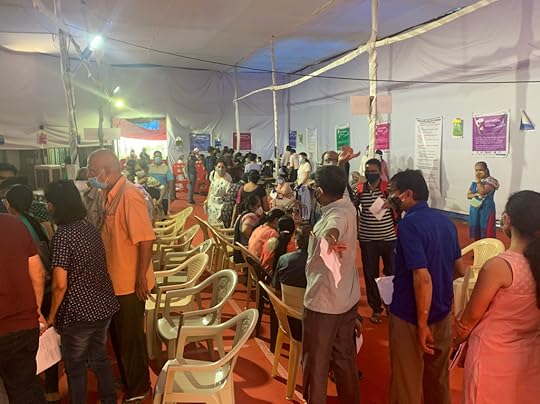
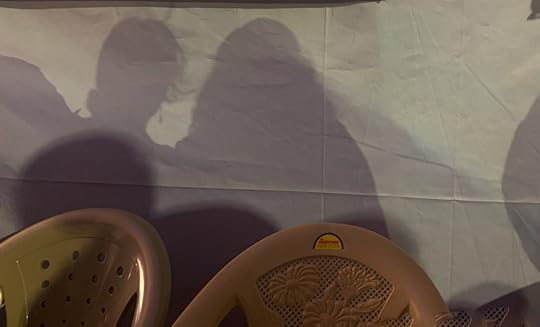
We do our best to touch nothing and no one in the pandal. They’ve lined up chairs for those waiting, but no one wants to sit despite having spent more than an hour standing. Next to our queue is another one for those getting their second shots. A woman in a white lab coat wanders into our queue and cuts in, right in front of Saumya. She doesn’t hear the nearby cop telling her she’s in the wrong queue. She doesn’t notice the stiff outraged bodies around her, of people who have seen her cut in. Normally, we’d tap her on the shoulder to attract her attention. Now we rely on telepathy. My gaze wanders to the vaccination slip she’s clutching in the hands interlocked behind her. She is a doctor, among those who were to be vaccinated during the first phase of the vaccination drive, which started in January. She’s come for her second shot now, in May. When she finally turns around, I notice the dark circles around her irritation-crinkled eyes. “Kuthey?” she growls angrily at the cop who has been able to get her to hear him. Where indeed. The lines are like shifty cells under a microscope. You see the order only if you know what you’re looking for. There are clusters of people grouped together, each trying to reach the vaccine counter quicker by attempting to expand distance from the one behind them and shrink the distance from the one ahead of them. It isn’t surprising that a fight breaks out in one corner. You can’t have this many privileged Indians in a room without at least one person trying to intimidate the staff. Nair Hospital, however, has been managing Covid and crowds for more than a year now. The raised voices and outrage are like water off a duck’s back. The angry older man sputters inconsequentially. Our line moves forward.
The actual shot takes less than a minute. There are eight counters and I’m sent to a woman who seems impossibly young, in scrubs that seem too large for her.
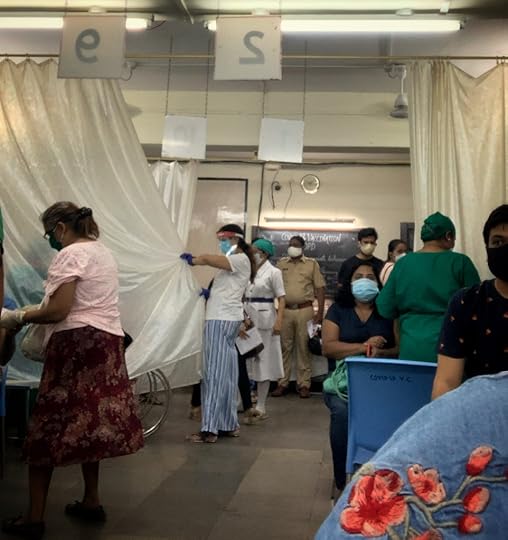
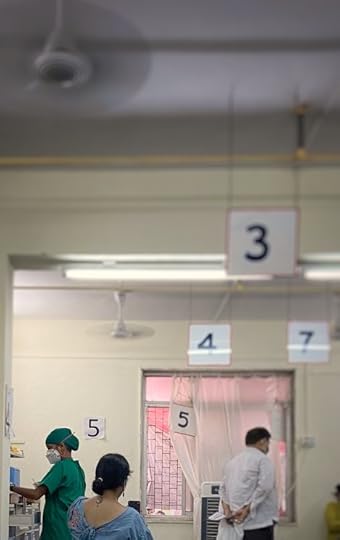
She tears off a fresh syringe from a strip, pulls out a vial from a green box, and I feel a pinch. It’s over before I know it. I’m now very impressed by the presence of mind of all those who managed to click photographs of themselves getting injected. It’s a dedication to photographic documentation — admittedly wrapped in narcissism, virtue signalling and leveraging social media — that I don’t possess. I’m more of a write-an-elaborately-long blog post kind of girl.
There’s barely a drop of blood on the cotton that she presses on my arm after giving me the shot. She warns me that the injection spot will hurt and that I shouldn’t massage it or apply ice or heat packs on it. “People do all that?” I ask her. “You wouldn’t believe the things men do at the slightest pain,” she tells me and I assume she’s grinning under her mask. She tells me to have Crocin if I get a fever, to be careful for the next two weeks and to come back for my second shot after 45-60 days. She’s utterly unflappable and calm. I thank her before leaving. “It’s my pleasure,” she tells me in English. I should have asked her name, but I’m too focused on blinking back tears. Also, there’s already another person hovering nearby, waiting to assign someone to my spot.
As I settle down in the waiting area, I give thanks to all the gods and to Saumya, who’s sitting right next to me. We exchange notes. Saumya reminds me that we need to take a photo of the two of us, newly-vaccinated as we are. She has family on another continent and these photographs make those faraway folk feel like they’re present in her life, despite the distance. I know the feeling. That’s how I felt when my parents sent me photographs of their vaccine adventure last month. As we wait for the minutes to pass, I notice we’re all women in this particular spot — saris, ridas, jeans, salwars, blingy chappals, sneakers, plastic kohlapuris. A little India, patiently waiting for the time when we will walk free and in the meantime, keeping the peace and the faith.
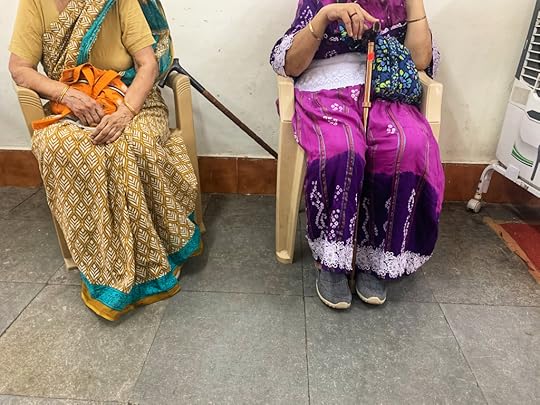
Twenty four hours later, when I’m feverish and aching, that waiting area will come back to me again and again. I find myself wondering how many of those women are feeling like I am, if someone is feeding them khichdi and giving them the Crocin.
Deepanjana Pal's Blog
- Deepanjana Pal's profile
- 34 followers



